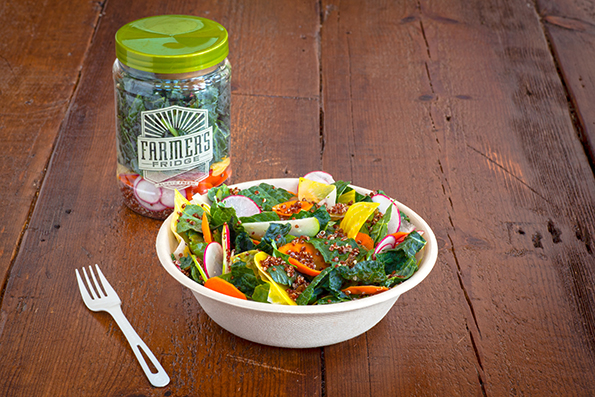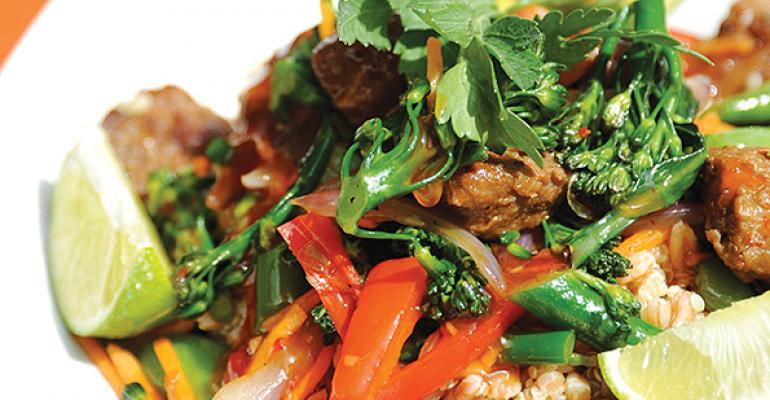
Luke Saunders was a busy traveling salesman for much of his career, and struggled to find healthy food for his on-the-go lifestyle. So in 2013 he fixed it when he opened his first healthful food kiosk called Farmers’ Fridge.
Today, the kiosk — an oversized vending machine loaded mostly with salads made fresh that morning and stored in Mason jars — has 30 locations in the Chicago area, with plans for up to 100 and designs on taking the concept national.
“There’s huge demand for better quality food,” Saunders said. “People are really demanding better options, premium ingredients and food taste that’s elevated and more convenient. A lot of times those two things aren’t in alignment.”
Farmers’ Fridge is part of a rapidly growing generation of restaurant chains aimed at solving a decades-long problem: How to make healthful food more convenient at a price point — and taste profile — that consumers want.

Numerous upstart concepts target the Whole Foods crowd: Sweetgreen, Chop’t, Tender Greens, Lyfe Kitchen and the Greek fast-casual concept Cava Mezze Grill, among many others.
Many of these chains are attracting the attention of private-equity investors and venture capitalists that see an opportunity to provide healthful food conveniently, and at a lower price point.
“There’s no question Americans’ eating habits are changing,” said Cristin O’Hara, managing director at Bank of America Merrill Lynch. “They’re trying to eat healthy.”
Yet restaurant chains have traditionally had a difficult relationship with the concept of healthful food.
Consumers have long said they want restaurant foods that are healthful, and that they plan to eat at restaurants they consider healthful. Nearly three quarters of consumers tell the National Restaurant Association, for instance, that they’re more likely to eat at a restaurant with healthful options. As such, legacy chains have frequently developed better-for-you items, hoping to satisfy those consumers.
And yet it’s been difficult actually selling those items. According to the NPD Group, sales of items with attributes traditionally considered to be healthful, like low-calorie, low fat or “diet,” have fallen more than 25 percent since 2008.
Restaurants are considered an indulgence, and many consumers don’t want to compromise when they dine out.
“I rarely say the ‘H’ word,” said Mike Donahue, co-founder and chief brand officer at Memphis, Tenn.-based Lyfe Kitchen — which deliberately avoids labeling its food as "healthy," to prevent consumers from getting the wrong idea. “People still want to measure their food on taste and experience. They want taste without sacrificing anything.

“I prefer ‘food with benefits.’ All the people who tried and failed, they perpetuated the 'H' word. It was too expensive. Our job is to dispel and bust those myths, you can have great tasting, good-for-you food.”
Lyfe Kitchen was founded by a group of former McDonald’s executives, including Donahue, as well as investors, with the help of world-class chefs. The company's aim is to develop a nationwide chain of guilt-free limited-service restaurants serving low-calorie items made with all-natural ingredients.
The company considers it its challenge to get people to think they’re indulging, even when they eat healthfully. “It’s the veto vote in reverse,” he said. “We see our target audience, our strategic audience. They’re there. And they’re coming, the ones that are really passionate about their diets. But there are also those who are a little apprehensive. They’re afraid of the 'H' word. We tell them to come and taste. ‘You’ll come back. You don’t have to sacrifice one for the other.’”
Still, what consumers consider healthful has changed. Once thought to be low calorie or low fat, consumers now want freshly prepared food with as few ingredients as possible.
“There’s a difference between good calories and bad calories,” Donahue said. “If you have 1,000 of cantaloupe, that’s very different from 1,000 calories of sweet roll.”
Those items are often more expensive, and are difficult to purchase and supply.
“Chains are coming to terms with a widening competitive set,” said Debra Bachar, a food industry consultant. “Consumers are increasingly experimenting with sources for fresher, healthier foods available from new and unexpected channels.”
Breaking the labor mold
The costs associated with these fresher items, coupled with consumers’ demands that food taste good and be convenient, has some concepts taking a sledgehammer to the traditional restaurant labor model.
Consider Eatsa. It has a single location near the Bay Bridge in San Francisco. And yet it has the potential to revolutionize the restaurant business — all because it dusted off the old automat concept.
Older consumers may remember the automat, in which meals wrapped in wax paper were stored behind glass, which lifted when a diner inserted coins. It was a fast-food concept that died with quick-service chains like White Castle, KFC and McDonald’s.
Eatsa doesn’t use coins, or even currency. Consumers order via iPad. Food is made fresh and then delivered to a glass case. The menu is all healthy, including bowls and salads with a quinoa base.
The high-tech, low-labor model enables the chain to sell healthful, customizable food more quickly, at a price point of $6.95.
“We identified an opportunity to respond to customers, especially Millennials, who are tired of making compromises,” said Scott Drummond, chief design officer of Eatsa. “They’re tired of compromising on speed. They’re tired of compromising on price. And they’re tired of compromising on health and flavorful.
“When you look at how we’re resonating, they don’t understand why food has to be unhealthy and not fast at all.”

Drummond said the company is comfortable with the automat analogy — to a point. “There’s one exception: That concept was associated with food that wasn’t fresh and oftentimes not very flavorful because it was sitting in plastic wrap for three days,” he said.
Eatsa is fully automated, using a lot of technology in a futuristic setting — fitting in the tech-savvy Bay Area. Orders typically take two to three minutes to fill, or five minutes during peak periods.
“You don’t talk to a cashier,” said Drummond, who co-founded the concept with Tim Young. “You order on an iPad. It gives you the ability to personalize and control your experience. You navigate through the environment.”
The technology not only increases customization, but it learns customer preferences, much like Amazon recommends books or Netflix recommends movies.
Growing the concept
Drummond and Young are technology industry veterans who spent 18 months working on the system, with funding from a former insurance company entrepreneur, David Friedberg. Their staff includes software engineers, food scientists and people with expertise in automation and robotics.
The team spent 18 months developing the concept. “It’s really a unique hybrid,” Drummond said. “It’s the way you would attack this if you didn’t go through a traditional way. We didn’t even start with it thinking of a restaurant.”

The concept has proven popular much quicker than its founders expected — at its peak, the location serves 300 to 400 customers per hour. The company currently has a second unit under construction in San Francisco, and plans to open 10 locations next year.
“We sort of valued the idea that we could upset the apple cart in fast food,” Drummond said. “We want to create more access to healthy food. For most people, especially lower wage workers, healthy, nutritious food is not a reality.”
Saunders, likewise, has big ambitions for his kiosk concept, Farmers’ Fridge. Salads, snacks and breakfast items are made fresh daily from a central site, and distributed every night to each of the kiosks. Food from the previous day is removed and taken to food shelves and other charitable organizations.
Saunders acknowledges that his concept was a risky one. “I used to have panic attacks wondering if anybody would buy lunch out of a vending machine,” he said, noting that he is out of that phase now.
He did note that the biggest hurdle for any of his kiosks is simply getting people to try it. But the food, and the way it is presented inside the Mason jars, has won acclaim.
The company has kiosks in hospitals, universities and in other areas where consumers are on the go, but demand more healthful items. Menu items include a Shrimp & Succotash Salad with grilled shrimp, romaine lettuce, asparagus, tomato, roasted corn, edamame and yogurt-basil dressing.
While the chain doesn’t spend money on cashiers or wait staff, it does pay for a distribution network. It also pays its prep cooks higher wages and expects higher quality work from them. In other words, prime costs are in line with typical restaurants.
“Our goal is to reinvest in the business with the money we’re saving on front-of-house costs,” he said. “This wouldn’t work if we pocketed the difference.”
Contact Jonathan Maze at [email protected]
Follow him on Twitter: @jonathanmaze





